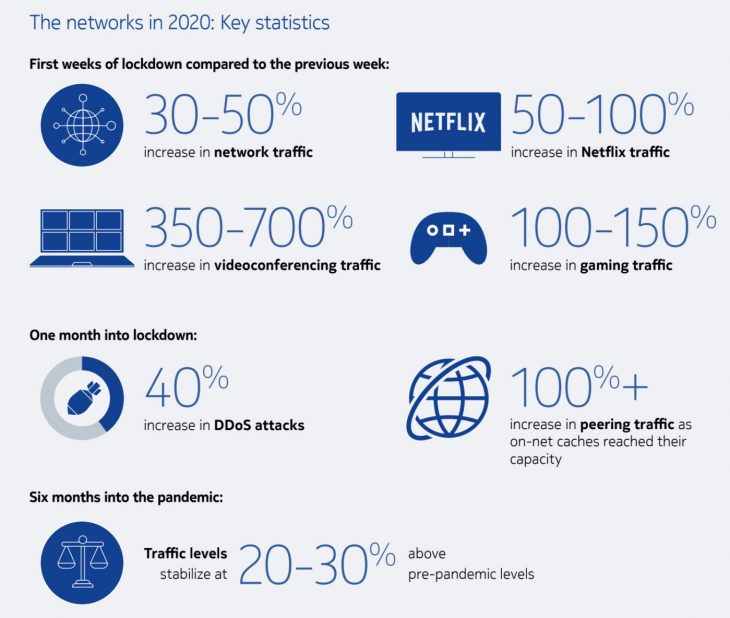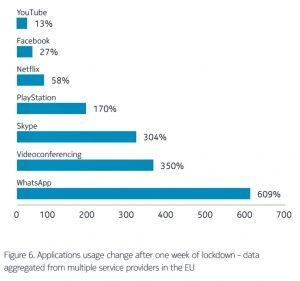
By John Bugailiskis
DESPITE EXPERIENCING THE equivalent of a “year’s traffic growth in just a few weeks,” after Covid lockdowns went into effect, IP networks around the world were able to handle the strain.
This, according to the “Nokia Deepfield Network Intelligence Report: Networks in 2020” which draws on data recorded by network service providers in Europe, North America and Latin America between February and September 2020.
Launched out of Michigan in 2011, Deepfield was a privately held company that provided real-time big data analytics to clients around their IP network performance and security, insights that can also help identify DDoS (Distributed Denial of Service) attacks. It was acquired by Finnish telecom giant Nokia in 2016. On Tuesday, Nokia held a webinar to expand upon the findings of the 51-page report.
“The immediate impact of the pandemic was significant almost overnight, or at least in the space of one to two weeks. We saw traffic peaks grow anywhere from 60 to 80% in some networks, with some providers growing 45% in one week,” says Dr. Craig Labovitz, CTO, Nokia Deepfield.
Not surprisingly, video was the dominant application that drove growth said Labovitz. “But we also saw equally significant growth of 350 to 600% in many of the video conferencing applications, as well as PlayStation for example, growing a 170% in just a matter of days.”
By the end of March, the major concern Nokia had from an engineering perspective was if there was sufficient capacity from provider networks around the U.S. and the world to handle a continued 30 to 40% growth rate. Labovitz noted that most operators generally build their networks to handle up to a 40% growth over the course of an entire year. “Few have the capacity to grow 30 to 40% week after week and month after month,” he added.
Fortunately, as the pandemic continued into April the “level of traffic volume stabilized at, give-or-take, 20 to 30% above pre-pandemic levels” reports Labovitz. In his webinar presentation Labovitz then focused on some of the more notable changes in usage behaviours created by having millions of people suddenly forced to work from home.
“In addition to media we saw a really significant uptick in gaming web VPN usage,” said Labovitz. He noted that also driving the growth in network traffic was the usage of IoT devices. “The growth of IoT is perhaps not directly related to the pandemic, but part of the ongoing trend as more and more HD and SD Nests and Ring (video doorbells) etc. cameras are deployed that are constantly streaming video up into the cloud,” added Labovitz.
“The shift created significant challenges for providers, with videoconferencing platforms overwhelmed with demand for real-time video processing, and service providers having to deal with huge demand for upstream bandwidth from residential connections that weren’t designed for heavy upstream use.” – Nokia
In the first days of the lockdown, the report found that the most significant increases recorded was in the use of WhatsApp and other communications apps as people turned to messaging apps to stay in touch with friends, school friends, family, and colleagues.
Labovitz also noted another noticeable trend as the pandemic took hold was a steady increase in the overall volume of DDoS (dedicated denial of service) traffic. Aggregated data from five large service providers revealed that by April DDoS traffic exceeded pre-pandemic levels by 40%. In particular, the rise of online gaming has led to more and shorter DDoS attacks, often targeted at a single host, creating challenges for service providers in detecting and protecting against attacks.
The Covid-19 pandemic didn’t just transform downstream video consumption. Patterns of upstream traffic shifted too, as people started working from home for extended periods. Generally, Deepfield customers recorded an upstream bandwidth increase in the range of 30-35%, which it attributed mainly to the increased use of cloud collaboration and videoconferencing.
“The shift created significant challenges for providers, with videoconferencing platforms overwhelmed with demand for real-time video processing, and service providers having to deal with huge demand for upstream bandwidth from residential connections that weren’t designed for heavy upstream use,” according to the report.
Service providers also witnessed a rise in VPN traffic as people connected from home. While this initial growth was not significant in some networks, others recorded growth of about 80%, with significant traffic on weekends. “Many corporate VPN infrastructures were seriously challenged, as they had not been designed to support that many remote workers concurrently. The solution for many companies was to move to cloud-based collaboration,” found the report.
The report also highlighted how the pandemic dramatically shifted OTT viewing to earlier in the day. For Netflix, it noted there was a 97% increase in morning traffic volumes over the previous week and a 27-42% increase in the early afternoon. By contrast, weekday evening viewing remained “relatively manageable, with only a 20% increase over a pre-pandemic weekday evening.” Weekend streaming, however, “skyrocketed.” At the first ‘busy hour’ after lockdown, there was a 54–72% rise in Netflix traffic volume over the previous weekend’s busy hour.



